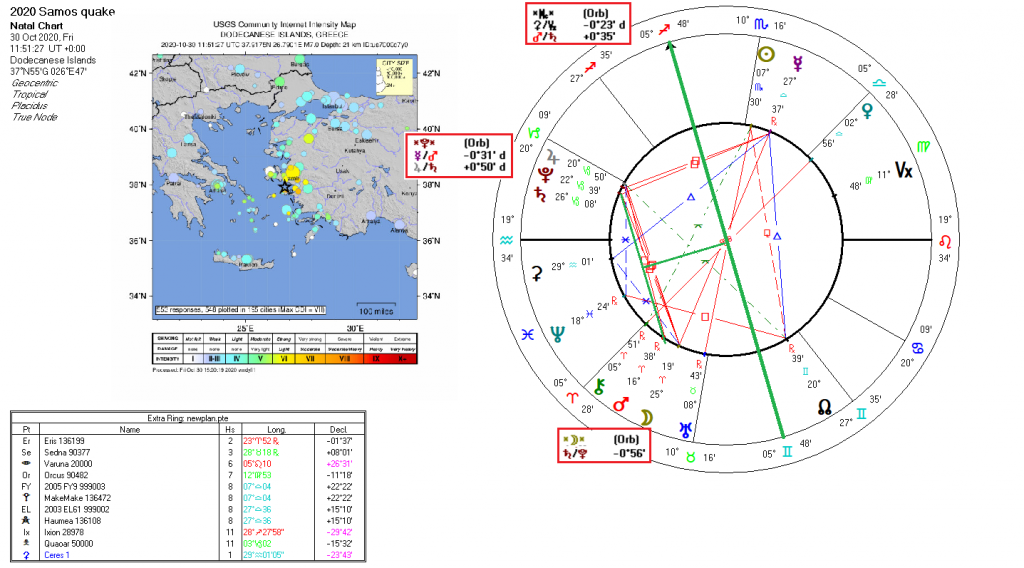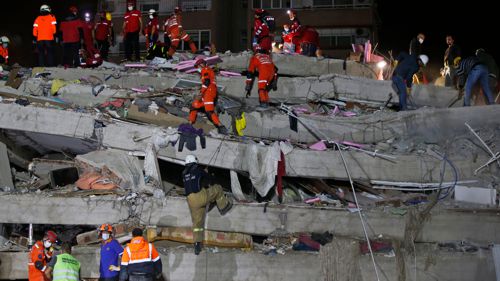At 11:51:27 UT, a magnitude 7.0 earthquake struck off the coast of the Greek island of Samos in the Dodecanese islands off the coast of Turkey. As of now there have been 2 dead and 19 injured reported in Greece and 25 dead and 804 injured in Turkey. The Turkish city of Izmir was the hardest-hit by the quake with extensive damage reported. Since the quake occurred in coastal waters, it spurred a tsunami, with social media posts showing water rushing through the streets in several coastal regions. The quake was the result of normal faulting at a shallow coastal depth. The area is prone to earthquakes and lies along the fault line between the Anatolian and Aegean Sea plates.
The quake was large enough that it was felt as far away as Athens and Istanbul. For background, Wikipedia had the following entries about it, with the reference articles hyperlinked:
Many buildings were damaged or collapsed as a result of the earthquake, with the Church of the Virgin Mary in Karlovasi, Greece, partially collapsing, while in the Turkish city İzmir, which was heavily affected by the earthquake, dozens of buildings were either damaged or completely collapsed. Emergency services in both countries immediately attended the scene, as rescue efforts continued into the night…Following the earthquake, Turkey was affected by 114 aftershocks…
Right after the earthquake, Turkish Minister of Health Fahrettin Koca stated that about 40 ambulances, 35 emergency rescue teams and two ambulance helicopters had reached the scene, while Turkey’s Ministry of National Defence stated that one of its planes had departed from Etimesgut Air Base to transport AFAD and gendarmerie teams to the region. The Turkish Red Crescent immediately deployed teams from six cities to provide food to those affected by the earthquake. More than 1,200 workers were involved in rescue efforts involving at least 13 buildings in İzmir, which continued into the night. Turkish authorities stated that 70 people were rescued, while the local government had set up tents to house about 2,000 people overnight…
Turkish president Recep Tayyip Erdoğan and Greek premier Kyriakos Mitsotakis have exchanged uniting statements following the earthquake and declared readiness to help one another.
The latter statement may raise a few eyebrows with some readers, given the recent tensions between Greece and Turkey. We’ll have a further statement on that later in this piece. With this background in mind, let’s have a look at the chart, below (bigger):

Aside from the Sun/Uranus opposition, the chart itself on the surface would appear to be rather nondescript. When we add in the midpoints, though, even at simply the 90° modulus, there are two main features in the chart: the Sun opposite Uranus and the midpoint MC=Mars/Saturn, both of which combined in a chart point to a possible disaster, with deaths and injuries involved. This is further enhanced by the midpoint Pluto=Jupiter/Saturn.
In the case of earthquakes, the Meridian axis is a more important consideration than the Horizon axis. The former represents the damage to infrastructure (4th house) and to people’s lives (general public and 4th house) and the government response to the event (10th house). Services are also important in a disaster chart, represented by the 6th house, as are the institutions such as hospitals and the like, represented by the 12th house. As it happens, the rulers of those two houses (the Moon and Saturn) are squared in the figure, showing the tensions in the situation, with hospitals (12th house) already stressed from the pandemic, especially in Turkey with the hundreds injured.
When it comes to earthquakes, planetary combinations with Pluto (Lord of the Underworld) must always be considered. The Pluto=Jupiter/Saturn midpoint has been with us for some days now, and in general represents the following: “A person unafraid of any trouble or work in order to attain the desired aims slowly but surely [emergency services], the demonstration of immense effort. – Violent changes [the quake], separation, restriction.”
Sun/Uranus combinations are shown in sudden turns of events, as in revolutions, disasters, upsets, military call-ups, social reforms and the like. The transiting Sun and Uranus were opposed in the event chart, with the Sun approaching and almost within a degree of the opposition. This represents the prime ‘upset’ in the chart.
The midpoint MC=Mars/Saturn (Mars/Saturn being the ‘death axis’) has the following manifestations: “Endurance, the power of resistance, indefatigableness. – The necessity to overcome a lot of difficulties in life, the ability to bear the suffering of the soul (with dignity and without complaint). Mourning and bereavement (death).”
Orcus was on the Vertex of the chart, giving almost a punishing, if not corrective tone to the event, which is indicated also through the degree of the Ascendant, discussed shortly.
Lastly we have the midpoint Moon=Saturn/Pluto, which among other things, points to ‘the tragic destiny of a woman’. In this case ‘woman’ can be substituted by ‘populace’, since the Moon represents the people in an event chart. The Moon also represents the emergency services in this chart, where Saturn/Pluto can also point to untiring work: “the participation in achievements brought about by large groups or masses of people, the pursuit of difficult work or of painstaking and thorough research in seclusion…” In this case, ‘seclusion’ would mean the people for which the emergency services were actually searching. The Saturn/Pluto conjunction, though wide, indicates the mass nature of the event and the scale of the death and injury, which was high.
Taken together, if one uses midpoints the nature of the chart reveals itself. In this case it was a violent disaster and a sudden, unexpected turn of events. And it occurred off the coast of Turkey. Mention was made previously about the tensions between Greece and Turkey, with the reference made about the exchange between the leaders of both nations. The rising degree of the chart is the 20th degree of Aquarius, which reads as follows:
“A large white dove bearing a message”
As we know, Aquarius is about group work and humanitarian pursuits. It was the Greek PM, Kiryakos Miçotakis, who approached Erdogan by phone immediately after the quake, offering his support to the people of Turkey – this after all the threatening posturing between the nations, especially by the Turks, in the Aegean Sea in response to Turkey’s pressing of issues in the area. The message represented in the chart is clear enough: Put aside your differences, find a point of peace and work together to get through the crisis. Erdogan’s response to Miçotakis was as follows:
“Thank you, Mr. Prime Minister.
I offer my condolences to all of Greece on behalf of myself and the Turkish people. Turkey, too, is always ready to help Greece heal its wounds.
That two neighbors show solidarity in difficult times is more valuable than many things in life.”
Emphasis added. Greece and Turkey have a long and sometimes troubled history. Erdogan needs all the help he can muster at the moment. His policies have left him overextended militarily, with rising debt, an economy in tatters and increasing antagonisms with his neighbors, most of this of his own making. There will be a post on the (mis)fortunes of Erdogan appearing on this blog in the near future.
Neither Greece nor Turkey can afford a conflict with each other in these times, especially with the sinking fortunes of the West. The Greeks especially need debt relief. With any luck at all, this event may help to plant seeds for cooperation instead of antagonism between these two ancient nations into the future. Meanwhile, we hold the souls of all the people badly affected by this event in our prayers and meditations.
Featured pic from AP News


Visited Samos 4years ago…enjoyed our stay immensely.
May they recover and “Fix the new cracks”…quickly
Love to the people and land.